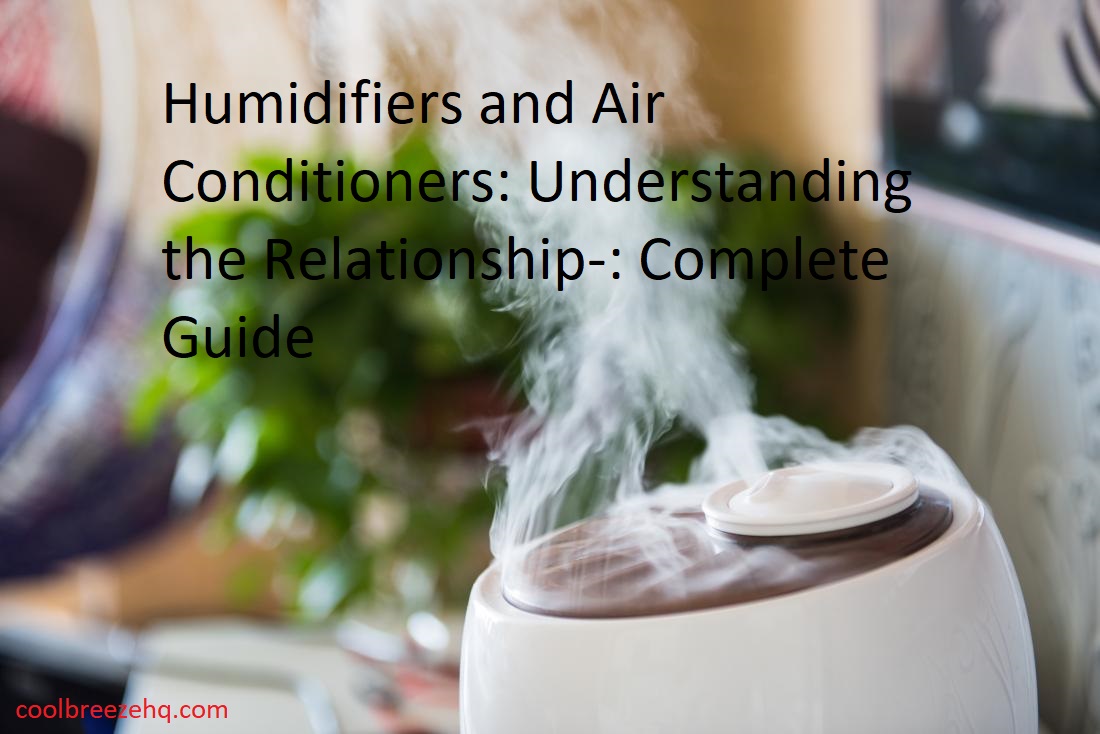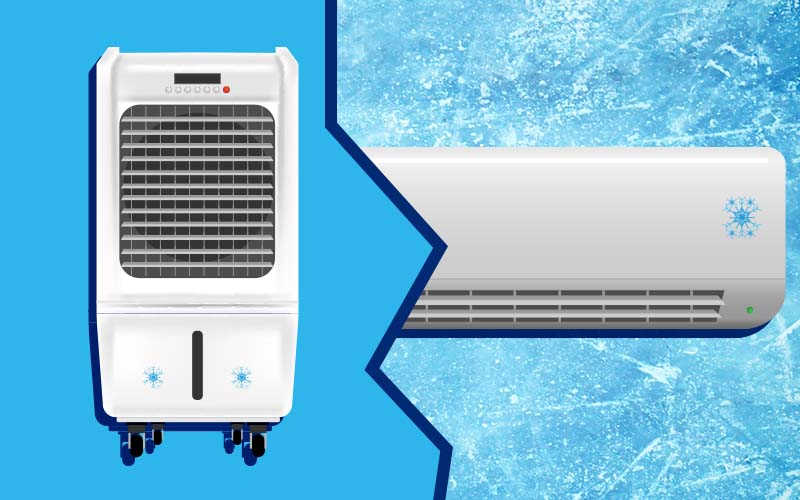Are you struggling to maintain comfortable air quality inside your home?
The relationship between air conditioners and humidifiers can help you keep your indoor air humidity levels in check. Discover the ideal balance of AC and Humidification to achieve optimum comfort in your living space.
Humidifiers and air conditioners can play an important role in creating the ideal temperature and humidity level in your home. But, it’s important to understand how the two systems work together to achieve optimum comfort in your living space.
This guide will explore the key differences between the two systems and how, when used together wisely, they can help you achieve a comfortable, optimal environment for yourself and your family. We will also take a look at some tips for maintaining both humidifiers and air conditioners so that they continue to create the atmosphere you desire in your home.
Air Conditioning and Humidity Control
Air conditioners work by cool air being forced over a surface containing a refrigerant. As the air circulates, the refrigerant absorbs heat from indoors, cooling and dehumidifying the indoor environment. In other words, air conditioners remove hot air and reduce humidity levels. This is why air conditioners are a popular way of controlling humidity levels in homes and businesses.
Humidifiers, on the other hand, increase moisture in the air by releasing water vapor into the atmosphere. Depending on where you live and your climate preference, you may find that adding a humidifier to your AC system can increase comfort levels in summer as well as winter months.
Humidity plays an important role when it comes to comfort levels indoors and controlling your system’s relative humidity can help you optimize your energy bills since higher indoor humidity can reduce how hard you have to run your AC for consistent comfort levels throughout the year. It’s important that you take measures to guard against excess humidity when running both an AC system and humidifier together since if not maintained properly this could lead to mold or support other allergens in the home or business space resulting in poor health conditions over time.
Explanation of how air conditioners work
Air conditioners, or ACs, are used to heat or cool the air in a space by controlling the humidity level. When the humidity is turned up, moisture is drawn out of the air and condensed into a liquid form (known as condensate). This condensate then collects at the bottom of the unit where it can be drained away.
A fan blows air over an evaporator coil, which is filled with refrigerant. As this airflow passes over the cool coils, its temperature drops and it precipitates moisture from warm air in your home. The condensate then flows through a drain line to be collected or directed elsewhere. The cooled air is then blown back into your living space by another fan while still discharging old warm air outdoors.
Equally significant to cooling capacity is energy efficiency. Many companies try to ensure their customers get both value and performance by including integrated energy-saving elements, such as adjustable temperatures and humidity levels, quiet operation modes and other features depending on each model in particular.
Role of air conditioners in controlling humidity
Air conditioners do more than just cool a space – they also play an important role in controlling indoor humidity levels. The way that a room is cooled by an AC unit influences how much moisture gets expelled from the air. If set too low, the air conditioner can dehumidify the air too much – causing dry eyes, chapped lips and irritated skin for occupants. This can be particularly troublesome in rooms where allergens or irritants may be present in the air, such as Hay fever suffers in bedrooms.
On the other hand, if air conditioners are set too high they may not expel enough moisture from the air and can cause a build-up of humidity – which serves to perpetuate infection-carrying bacteria and mold.
The most effective way to keep indoor humidity levels at a safe level is to use an appropriate combination of an AC unit, fan and humidifier. By adjusting these components appropriately, you can keep your home comfortable while minimizing any health risks posed by excessive humidity levels or drying conditions.
Humidifiers and their Benefits
Humidifiers are devices that introduce moisture into the air. This, in turn, helps to reduce irritation of the skin and respiratory system by creating a moist environment, while also providing comfort and health benefits. Additionally, with the proper humidity levels, interior air is less likely to harbor dust mites or other allergens.
Humidification can be a highly effective way to improve indoor air quality for those who suffer from allergies and asthma, as well as for those who live in dry climates or reside in homes where there is little natural ventilation. When used correctly, humidifiers help maintain humidity levels between 40%-60%, which is proven to be ideal for human health. Lower levels can cause dry skin and throat irritation while higher humidities can promote mold growth or increase dust mite populations.
Furthermore, by adding moisture to the air it can act as a buffer against sudden fluctuations in temperature created by an air conditioner unit. This helps keep temperatures within a more comfortable range while also reducing energy usage by allowing your AC unit to run at maximum efficiency without rapid on/off cycling.
Explanation of how humidifiers work
Humidifiers are devices used to add moisture to indoor air. By controlling the amount of humidity in a room, humidifiers provide comfort and health benefits such as reduced static electricity, easier breathing, improved sinus health and fewer allergy symptoms. There are two main types of humidifiers – evaporative and steam.
Evaporative humidifiers work by using a fan to draw in dry air through a filter or wet pad. As the air passes through the pad, it absorbs some of the water molecules and evaporates them into the room. This method is relatively cheaper than steam humidification because it does not require heating for evaporation – making it an efficient choice for large areas such as homes and offices that require humidity control over long periods of time.
Steam humidifiers produce a fine mist by heating up water until it boils, sending particles into the air that are then absorbed into the atmosphere around them. This method is typically more expensive than evaporative technology but is ideal for rooms where humidity control is needed quickly and accurately – such as in server rooms or incubators for newborns.
Benefits of using humidifiers
Humidifiers have many benefits when used in conjunction with air conditioners. One of the most notable is improved air quality: humidifiers add moisture to the air and reduce the risk of dust mites, bacteria, and seasonal viruses that can cause respiratory difficulties.
Additionally, a good balance between humidity levels and temperatures will help you feel cooler at higher thermostat settings. When using a humidifier with an air conditioner, less energy may be required to maintain desired room temperatures — thus resulting in potential cost savings on your monthly energy bills.
Finally, humidifiers can prevent cracking or peeling of walls caused by low humidity levels in the home.
Maintenance and Cleaning
It is important to keep humidifiers and air conditioners in good working order to ensure proper air quality and prevent buildup of bacteria or mold. Regular maintenance will also extend the life of your equipment, save energy and money, and reduce allergens such as dust mite dander and pollen.
Regular cleaning of your humidifier and air conditioner parts, at least once a month, is essential in preventing mold, mildew, and bacterial growth which can cause health-related problems. Make sure to empty all chambers regularly according to the manufacturer’s instructions. Unplug the humidifier before you clean it. Check the water tank for signs of calcium buildup or other sediment deposits. If present, you should remove these using a soft cloth or brush. Rinse with warm water until all debris is removed then dry thoroughly with a clean cloth or paper towel.
If you have an evaporative humidifier or steam vaporizer, replace the filter according to instructions. A worn out filter will not perform its job properly – trapping particles that could be released into your home air – so make sure it’s replaced regularly to keep your machine working efficiently and maintain healthy indoor air quality:
For central heating systems with built-in humidifiers, inspect the system for any duct blockages every 1-2 months as per manufacturer’s instructions. Filters must be replaced periodically (every 3-6 months) depending on usage in order to supply clean air throughout your home environment: replacing filters too often can increase energy costs but keeping them for too long can cause poor performance from your equipment.
Importance of maintaining and cleaning humidifiers and air conditioners
Maintaining and cleaning your humidifier and air conditioner units is essential in ensuring they continue to perform optimally. Properly maintained humidifiers and air conditioners help increase the lifespan of the components, reduce energy consumption, improve air quality, and decrease indoor humidity levels.
Equipment maintenance should always start with a thorough cleaning. This is especially important for central air conditioning systems. Dirt, dust, and other debris can clog filters or restrict airflow through the HVAC system leading to poor performance. Cleaning your unit on a regular basis helps keep the components in good working order for longer periods of time which reduces energy consumption and utility costs as well as improving air quality in your home or business environment.
Keeping an eye on materials that make up both units helps prevent corrosion from occurring due to humidity levels as well as humidity-related damages like mold growth inside heating systems or coolers. Regular maintenance will keep both units running at their peak performance level while reducing replacement costs since components are replaced less often if they are kept clean and free of debris.
Tips for maintaining and cleaning humidifiers
Humidifiers need to be regularly maintained and cleaned in order to keep them running efficiently and safely. Here are some tips for keeping your humidifier running properly:
- Before each use, make sure the water is being dispensed from the humidifier’s tank or reservoir.
- Every week or two, empty the tank/reservoir and refill with fresh water following instructions in the owner’s manual of your device.
- Clean interior surfaces of the unit by using warm soapy water, if necessary, following instructions in the product’s user manual. Make sure all pieces of debris are removed before putting it back together again and reassembling it correctly after cleaning.
- If you have a filter-based humidifier, be sure to check and clean out mineral deposits that build up inside the filter over time as they can affect its efficiency.
- When cleaning around areas where electricity is present in your device, make sure power is off at the circuit breaker before de-energizing your unit as a precautionary measure for personal safety.
- Clean and replace internal filters of your filters when necessary for best results.

Tips for maintaining and cleaning air conditioners
Air conditioning systems must be maintained in order to keep them running properly and providing optimal energy efficiency. It is best to have your HVAC technician check out your unit once a year to make sure all is functioning properly; however, there are several easy tips homeowners can do to maintain their AC systems and help prevent costly repairs down the line.
- Check the air filter regularly and clean or replace if necessary – a clogged air filter reduces airflow, restricts the system from working optimally and increases energy costs.
- Monitor the coils of your system for dirt, dust and debris buildup – use compressed air or a soft brush (not steel wool) to gently remove dirt from the coils.
- Keep outdoor units free of vegetation – trim shrubs, plants and trees at least two feet away from any side of the AC unit.
- Check for proper drainage of condensation – before each cooling season inspect for standing water near units; repair drainage problems immediately as standing water can cause damage that leads to costly repairs later on.
Cleanliness of an AC system is key; if you notice mold or mildew growth inside it’s time to call a professional technician as this could be an indication that there is too much moisture in the system itself. Additionally, keeping up with regular maintenance and cleaning will help extend the life of your system, reduce breakdowns over time, keep energy costs low and ensure you’re getting cold air when you need it!
Conclusion
Ultimately, the relationship between humidifiers and air conditioners is complex and highly dependent upon the unique needs of each individual space. In some cases, adding a humidifier to a space with an AC unit may be an effective way to create a more comfortable working or living environment. Under certain conditions, using a humidifier in conjunction with an air conditioner can also help to maintain acceptable relative humidity levels and mitigate adverse health impacts caused by dry air.
On the other hand, improper installation or maintenance of the equipment can lead to excessive moisture buildup inside the home, which could potentially cause issues such as mold growth and structural damage. As such, it is important for individuals considering this combination of systems to properly research their options and consult with experts before making any decisions.
FAQ
How does a humidifier work with air conditioning?
A humidifier adds moisture to the air while air conditioning removes moisture, so they can work together to achieve a comfortable and healthy indoor environment.
What is the relation between AC and humidity?
Air conditioning reduces humidity by removing moisture from the air. It cools the air by passing it over a cold surface, which causes the moisture to condense and collect in a drip pan or drain line.
What is the difference between air humidifier and air conditioner?
An air humidifier adds moisture to the air, while an air conditioner removes moisture and cools the air. They serve different purposes but can be used together to create a comfortable indoor environment.
Which humidifier is involved in air conditioning system?
A whole-house humidifier can be integrated into an air conditioning system to add moisture to the air and provide a more comfortable indoor environment.
Do all air conditioners have humidifiers?
No, not all air conditioners have humidifiers. Humidifiers are a separate component that can be added to an air conditioning system if needed.
Does an air conditioner humidify a room?
No, an air conditioner does not humidify a room. It removes moisture from the air to reduce humidity levels and create a more comfortable indoor environment.
Is AC a humidifier or dehumidifier?
An AC is a dehumidifier. It removes moisture from the air to reduce humidity levels and create a more comfortable indoor environment.
Can I add a humidifier to my air conditioner?
Yes, you can add a humidifier to your air conditioning system. A whole-house humidifier can be integrated into the HVAC system to add moisture to the air.
Why does AC increase humidity?
If the AC is not functioning properly or is undersized for the space it is cooling, it may not be able to remove moisture from the air effectively. This can lead to an increase in humidity levels.
Does AC cause high humidity?
No, an AC does not cause high humidity. It is designed to reduce humidity levels by removing moisture from the air. However, if the AC is not functioning properly, it may not be able to remove moisture effectively, leading to high humidity levels.
See more-
- Best through the wall air conditioner 2023
- Best sliding window air conditioner 2023
- Best rv air conditioner 2023
- Best quietest air conditioner 2023
- Best portable car air conditioner 2023

